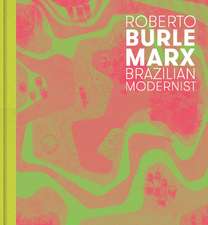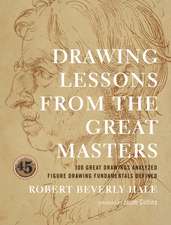Le Corbusier: Drawing as Process
Autor Danièle Pauly Traducere de Genevieve Hendricksen Limba Engleză Hardback – 20 noi 2018
“Each day of my life has been dedicated in part to drawing. I have never stopped drawing and painting, seeking, where I could find them, the secrets of form.”—Le Corbusier
Charles-Édouard Jeanneret, known as Le Corbusier (1887–1965), is famous for transforming 20th-century architecture and urbanism. Less attention has been paid to his artistic production, although he began his career as a painter. Le Corbusier indeed studied under Charles L’Éplattenier and, together with the artist Amédée Ozenfant, founded the Purist movement in the manifesto After Cubism. Even after Le Corbusier turned to architecture, he continued to paint and draw. His thousands of drawings, rarely exhibited but meticulously stored in two watch cabinets from his family home, were particularly significant; he considered his work as a draftsman to be fundamental to his creative process.
Beautifully illustrated with more than 300 drawings that have never before been published for an English readership, this revealing book charts the evolution of Le Corbusier’s process from his youthful travels abroad to his arrival and maturation in Paris. Danièle Pauly shows how his drawings functioned within an intimate zone of private reflection and situates his work within the broader artistic and intellectual currents of Cubism, Purism, Primitivism, and Surrealism. In addition to providing a crucial new background against which to comprehend Le Corbusier’s architecture and urbanism, this important volume advocates for understanding him alongside leading modern artists including Pablo Picasso and Fernand Léger.
Charles-Édouard Jeanneret, known as Le Corbusier (1887–1965), is famous for transforming 20th-century architecture and urbanism. Less attention has been paid to his artistic production, although he began his career as a painter. Le Corbusier indeed studied under Charles L’Éplattenier and, together with the artist Amédée Ozenfant, founded the Purist movement in the manifesto After Cubism. Even after Le Corbusier turned to architecture, he continued to paint and draw. His thousands of drawings, rarely exhibited but meticulously stored in two watch cabinets from his family home, were particularly significant; he considered his work as a draftsman to be fundamental to his creative process.
Beautifully illustrated with more than 300 drawings that have never before been published for an English readership, this revealing book charts the evolution of Le Corbusier’s process from his youthful travels abroad to his arrival and maturation in Paris. Danièle Pauly shows how his drawings functioned within an intimate zone of private reflection and situates his work within the broader artistic and intellectual currents of Cubism, Purism, Primitivism, and Surrealism. In addition to providing a crucial new background against which to comprehend Le Corbusier’s architecture and urbanism, this important volume advocates for understanding him alongside leading modern artists including Pablo Picasso and Fernand Léger.
Preț: 323.93 lei
Nou
Puncte Express: 486
Preț estimativ în valută:
61.98€ • 65.06$ • 51.45£
61.98€ • 65.06$ • 51.45£
Carte disponibilă
Livrare economică 20 martie-03 aprilie
Livrare express 05-11 martie pentru 77.100 lei
Preluare comenzi: 021 569.72.76
Specificații
ISBN-13: 9780300230994
ISBN-10: 0300230990
Pagini: 304
Ilustrații: 362 color + 50 b-w illus.
Dimensiuni: 241 x 279 x 26 mm
Greutate: 1.63 kg
Editura: Yale University Press
Colecția Yale University Press
ISBN-10: 0300230990
Pagini: 304
Ilustrații: 362 color + 50 b-w illus.
Dimensiuni: 241 x 279 x 26 mm
Greutate: 1.63 kg
Editura: Yale University Press
Colecția Yale University Press
Recenzii
“Artists, architects, historians and art lovers, as well as scholars, will encounter new dimensions to Le Corbusier through this penetrating analysis of the architect’s drawings.”—Anne Kugielsky, Antiques and the Arts Weekly
“Through the essays and illustrations, readers will discover how important drawing was to Le Corbusier’s overall creative process as an architect and urban planner and how 'drawing was naturally, from the very beginning, a tool for understanding the world.'”—Maine Antique Digest
“Thanks to this beautifully illustrated book by Danièle Pauly, artists, architects, historians and art enthusiasts will encounter new dimensions to Le Corbusier’s creative life among his drawings.”—Mardges Bacon, author of Le Corbusier in America
“Danièle Pauly’s brilliant survey of Le Corbusier’s drawings explores how the architect used drawings as inspiration for his paintings, but this beautifully illustrated book also shows how he used them to understand the world.”—Tim Benton, author of The Villas of Le Corbusier and Pierre Jeanneret 1920-1930
“In decades of research, Danièle Pauly has become the most knowledgeable scholar of Le Corbusier’s drawings worldwide. Thanks to her penetrating analysis of their genesis and their rhetoric, she is able to reveal the multiple layers of meaning condensed in them.”—Jean-Louis Cohen, author of Le Corbusier: An Atlas of Modern Landscapes
“Through the essays and illustrations, readers will discover how important drawing was to Le Corbusier’s overall creative process as an architect and urban planner and how 'drawing was naturally, from the very beginning, a tool for understanding the world.'”—Maine Antique Digest
“Thanks to this beautifully illustrated book by Danièle Pauly, artists, architects, historians and art enthusiasts will encounter new dimensions to Le Corbusier’s creative life among his drawings.”—Mardges Bacon, author of Le Corbusier in America
“Danièle Pauly’s brilliant survey of Le Corbusier’s drawings explores how the architect used drawings as inspiration for his paintings, but this beautifully illustrated book also shows how he used them to understand the world.”—Tim Benton, author of The Villas of Le Corbusier and Pierre Jeanneret 1920-1930
“In decades of research, Danièle Pauly has become the most knowledgeable scholar of Le Corbusier’s drawings worldwide. Thanks to her penetrating analysis of their genesis and their rhetoric, she is able to reveal the multiple layers of meaning condensed in them.”—Jean-Louis Cohen, author of Le Corbusier: An Atlas of Modern Landscapes
Notă biografică
Danièle Pauly is professor of architectural history at the École Nationale Supérieure d'Architecture Paris-val-de-Seine and director of the catalogue raisonné of Le Corbusier’s drawings. Genevieve Hendricks is assistant professor of modern art history at Hollins University.






